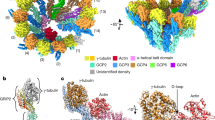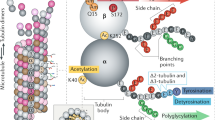Abstract
The centrosome organizes microtubules, which are made up of α-tubulin and β-tubulin, and contains centrosome-bound γ-tubulin, which is involved in microtubule nucleation. Here we identify two new human tubulins and show that they are associated with the centrosome. One is a homologue of the Chlamydomonas δ-tubulin Uni3, and the other is a new tubulin, which we have named ɛ-tubulin. Localization of δ-tubulin and ɛ-tubulin to the centrosome is independent of microtubules, and the patterns of localization are distinct from each other and from that of γ-tubulin. δ-Tubulin is found in association with the centrioles, whereas ɛ-tubulin localizes to the pericentriolar material. ɛ-Tubulin exhibits a cell-cycle-specific pattern of localization, first associating with only the older of the centrosomes in a newly duplicated pair and later associating with both centrosomes. ɛ-Tubulin thus distinguishes the old centrosome from the new at the level of the pericentriolar material, indicating that there may be a centrosomal maturation event that is marked by the recruitment of ɛ-tubulin.
This is a preview of subscription content, access via your institution
Access options
Subscribe to this journal
Receive 12 print issues and online access
$209.00 per year
only $17.42 per issue
Buy this article
- Purchase on Springer Link
- Instant access to full article PDF
Prices may be subject to local taxes which are calculated during checkout






Similar content being viewed by others
References
Oakley, B. R., Oakley, C. E., Yoon, Y. & Jung, M. K. Gamma-tubulin is a component of the spindle pole body that is essential for microtubule function in Aspergillus nidulans. Cell 61, 1289– 1301 (1990).
Stearns, T., Evans, L. & Kirschner, M. Gamma-tubulin is a highly conserved component of the centrosome. Cell 65, 825– 836 (1991).
Zheng, Y., Jung, M. K. & Oakley, B. R. Gamma-tubulin is present in Drosophila melanogaster and Homo sapiens and is associated with the centrosome. Cell 65, 817–823 ( 1991).
Stearns, T. & Kirschner, M. In vitro reconstitution of centrosome assembly and function: the central role of gamma-tubulin. Cell 76, 623–637 ( 1994).
Zheng, Y., Wong, M. L., Alberts, B. & Mitchison, T. Nucleation of microtubule assembly by a gamma-tubulin-containing ring complex. Nature 378, 578–583 ( 1995).
Detraves, C. et al. Protein complexes containing gamma-tubulin are present in mammalian brain microtubule protein preparations. Cell Motil. Cytoskeleton 36, 179–189 ( 1997).
Murphy, S. M., Urbani, L. & Stearns, T. The mammalian gamma-tubulin complex contains homologues of the yeast spindle pole body components spc97p and spc98p. J. Cell Biol. 141, 663–674 (1998).
Oegema, K. et al. Characterization of two related Drosophila gamma-tubulin complexes that differ in their ability to nucleate microtubules. J. Cell Biol. 144, 721–733 ( 1999).
Moritz, M., Braunfeld, M. B., Sedat, J. W., Alberts, B. & Agard, D. A. Microtubule nucleation by gamma-tubulin-containing rings in the centrosome. Nature 378, 638 –640 (1995).
Vogel, J. M., Stearns, T., Rieder, C. L. & Palazzo, R. E. Centrosomes isolated from Spisula solidissima oocytes contain rings and an unusual stoichiometric ratio of alpha/beta tubulin. J Cell Biol 137, 193–202 ( 1997).
Gould, R. R. & Borisy, G. G. The pericentriolar material in Chinese hamster ovary cells nucleates microtubule formation. J. Cell Biol. 73, 601–615 ( 1977).
Dutcher, S. K. & Trabuco, E. C. The UNI3 gene is required for assembly of basal bodies of Chlamydomonas and encodes delta-tubulin, a new member of the tubulin superfamily. Mol. Biol. Cell 9, 1293–1308 (1998).
Nogales, E., Wolf, S. G. & Downing, K. H. Structure of the alpha beta tubulin dimer by electron crystallography. Nature 391, 199– 203 (1998).
Nogales, E., Whittaker, M., Milligan, R. A. & Downing, K. H. High-resolution model of the microtubule. Cell 96, 79–88 (1999).
Knop, M., Pereira, G., Geissler, S., Grein, K. & Schiebel, E. The spindle pole body component Spc97p interacts with the gamma-tubulin of Saccharomyces cerevisiae and functions in microtubule organization and spindle pole body duplication. EMBO J. 16, 1550–1564 ( 1997).
Geissler, S. et al. The spindle pole body component Spc98p interacts with the gamma-tubulin like Tub4p of Saccharomyces cerevisiae at the sites of microtubule attachment. EMBO J. 15, 3899– 3911 (1996).
Burns, R. G. Identification of two new members of the tubulin family. Cell Motil. Cytoskeleton 31, 255–258 (1995).
Julian, M. et al. Gamma-tubulin participates in the formation of the midbody during cytokinesis in mammalian cells. J. Cell Sci. 105, 145–156 (1993).
Lajoie-Mazenc, I. et al. Recruitment of antigenic gamma-tubulin during mitosis in animal cells: presence of gamma-tubulin in the mitotic spindle. J. Cell Sci. 107, 2825–2837 ( 1994).
Albrecht-Buehler, G. & Bushnell, A. The ultrastructure of primary cilia in quiescent 3T3 cells. Exp. Cell Res. 126, 427–437 (1980).
Kochanski, R. S. & Borisy, G. G. Mode of centriole duplication and distribution. J. Cell Biol. 110, 1599–1605 (1990).
Rieder, C. L. & Borisy, G. G. The centrosome cycle in PtK 2 cells: asymmetric distribution and structural changes in the pericentriolar materiel. Biol. Cell 44, 117– 132 (1982).
Piperno, G. & Fuller, M. T. Monoclonal antibodies specific for an acetylated form of alpha-tubulin recognize the antigen in cilia and flagella from a variety of organisms. J. Cell Biol. 101, 2085–2094 (1985).
Lange, B. M. & Gull, K. A molecular marker for centriole maturation in the mammalian cell cycle. J. Cell Biol. 130, 919–927 (1995).
Nogales, E., Downing, K. H., Amos, L. A. & Lowe, J. Tubulin and FtsZ form a distinct family of GTPases. Nature Struct. Biol. 5, 451–458 ( 1998).
Frankel, S. & Mooseker, M. S. The actin-related proteins. Curr. Opin. Cell Biol. 8, 30–37 (1996).
Welch, M. D., Iwamatsu, A. & Mitchison, T. J. Actin polymerization is induced by Arp2/3 protein complex at the surface of Listeria monocytogenes. Nature 385, 265–269 ( 1997).
Paintrand, M., Moudjou, M., Delacroix, H. & Bornens, M. Centrosome organization and centriole architecture: their sensitivity to divalent cations. J. Struct. Biol. 108, 107– 128 (1992).
Lacey, K. R., Jackson, P. K. & Stearns, T. Cyclin-dependent kinase control of centrosome duplication . Proc. Natl Acad. Sci. USA 96, 2817– 2822 (1999).
Freed, E. et al. The SKP1 and CUL1 ubiquitin ligase components localize to the centrosome and regulate the centrosome duplication cycle. Genes Dev. 13, 2242–2257 ( 1999).
Bobinnec, Y. et al. Centriole disassembly in vivo and its effect on centrosome structure and function in vertebrate cells. J. Cell Biol. 143, 1575–1589 (1998).
Chomczynski, P. & Sacchi, N. Single-step method of RNA isolation by acid guanidinium thiocyanate- phenol-chloroform extraction . Anal. Biochem. 162, 156– 159 (1987).
Harlow, E. & Lane, D. Antibodies: a Laboratory Manual (Cold Spring Harb. Lab. Press, Cold Spring Harbor, NY, 1988 ).
Blose, S. H., Meltzer, D. I. & Feramisco, J. R. 10-nm filaments are induced to collapse in living cells microinjected with monoclonal and polyclonal antibodies against tubulin . J. Cell Biol. 98, 847– 858 (1984).
Sanders, M. A. & Salisbury, J. L. Centrin plays an essential role in microtubule severing during flagellar excision in Chlamydomonas reinhardtii. J. Cell Biol. 124, 795–805 (1994).
Mariani, B. D., Slate, D. L. & Schimke, R. T. S phase-specific synthesis of dihydrofolate reductase in Chinese hamster ovary cells. Proc. Natl Acad. Sci. USA 78, 4985–4989 (1981).
Acknowledgements
We thank A. Sidow for advice on sequence comparisons, and S. Murphy, K. Lacey and J.C. Zabala for comments on the manuscript. This work was supported by grants to T.S. from the NIH (GM52022) and from the Searle Scholars Foundation.
Correspondence and requests for materials should be addressed to T.S.
Author information
Authors and Affiliations
Corresponding author
Rights and permissions
About this article
Cite this article
Chang, P., Stearns, T. δ-Tubulin and ɛ-tubulin: two new human centrosomal tubulins reveal new aspects of centrosome structure and function. Nat Cell Biol 2, 30–35 (2000). https://doi.org/10.1038/71350
Received:
Revised:
Accepted:
Published:
Issue Date:
DOI: https://doi.org/10.1038/71350
This article is cited by
-
Translational regulation of δ-tubulin through its 5’-untranslated region
Molecular Biology Reports (2023)
-
A CRISPR-based screen for Hedgehog signaling provides insights into ciliary function and ciliopathies
Nature Genetics (2018)
-
Angulin proteins ILDR1 and ILDR2 regulate alternative pre-mRNA splicing through binding to splicing factors TRA2A, TRA2B, or SRSF1
Scientific Reports (2017)
-
A primer on the mouse basal body
Cilia (2016)
-
Human basal body basics
Cilia (2016)



